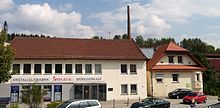Spiegelau glass
The Kristallglasfabrik Spiegelau GmbH is based in the municipality of Spiegelau in the Bavarian Forest . 20 million glasses are produced every year, mainly drinking glasses, decanting carafes and other crystal glass accessories. The Spiegelau glassworks was first mentioned in a document in 1521 . In 2008 production in Spiegelau was stopped. Since then, the Spiegelau Glas brand has been manufactured at other locations of the brand owner Riedel Glas .
description
In addition to drinking glass sets such as goblets and tumblers, as well as decanting carafes and jugs, the product range of the Spiegelau crystal glass factory also includes accessories for the set table (e.g. champagne coolers, vinegar and oil carafes, crystal glass plates and bowls).
The main markets for Spiegelau brand glasses are Europe, the USA, Asia and the Middle East. The company's export share is 80 percent.
With Riedel Glass Works, Spiegelau has its own sales companies in the USA, Great Britain, Japan, Australia and China.
Company history
Beginnings
The glassworks in Spiegelau was first mentioned in a document in 1521 , when the Grafenau citizen Erasmus Mospurger bequeathed his two mirror glassworks Spiegelau and Klingenbrunn to the Grafenau parish church in a will. In 1568, Spiegelaw was marked as a mirror factory in Philipp Apian's ” Map of Bavaria ” . The seat of the "Herrenhof" with agriculture, brewery and outbuildings was Klingenbrunn . The smelter owned two smelter rights, so that he could always maintain two locations for the actual glass production. After almost a century of existence, the glassworks known for its mirror production moved to Ochsenkopf Klingenbrunn, and later to Althütte and Neuhütte. Some locations have been used several times over the centuries. Only the Spiegelau mill remained of Spiegelau .
19th century
In 1832 the Kingdom of Bavaria acquired the glassworks with all of the lands and forests that belonged to it. The buildings and production facilities were sold to private investors. The forests remained in state ownership. The owner consortium sold the Klingenbrunner Neuhütte in 1838 to the hardware dealer Anton Hellmayer from Deggendorf , thus ending the centuries-old association of the Spiegelau and Klingenbrunn locations. In 1839 he moved the glassworks to Spiegelau.
In 1842, the haulier and beer brewer Anton Stangl from Zwiesel bought the company for 21,000 guilders. After Anton Stangl, his son Ludwig Stangl ran the Stanglhütte . In 1874 35 employees produced grinding and hollow glass. At the end of the 19th century, production was expanded to include the artfully designed snuff bottles, which were very popular at the time. After Ludwig Stangl's death in 1898, his son Ludwig Stangl junior ran the business until his death in 1905.
The 20th century
In 1908, after several changes of ownership, Anton Hilz and Ferdinand Dallmayer took over the company, which was expanded and modernized in 1911. In 1912 the hut ran into financial difficulties and was bought by Millitzer & Münch , who shut it down in 1913.
After the end of the First World War, the Bing Group took over the glass factory in Nuremberg , which was acquired in 1926 by its director, Kommerzienrat Fritz Pretzfelder. In the same year she took on her company, which is still valid today : Kristallglasfabrik Spiegelau GmbH . Because of his Jewish origins, Pretzfelder had to sell the company well below its value in 1939 and emigrate. Paul Beate and Hans von Schöppenthau ran the glass factory during the Second World War.
After the end of the war, the hut was managed in trust until Pretzfelder took over again as Frederik Preston in 1949. The favorable development of the glass factory under the direction of the director Danzmann played a major role in the fact that in 1959 the community name of Klingenbrunn was changed to Spiegelau.
In 1962, after Preston's and Danzman's deaths (1961 and 1962), the Spiegelau glassworks was transferred to a branch of the Württembergische Metallwarenfabrik , and in 1963 to Union Sils, van de Loo & Co., Fröndenberg / Ruhr . This acquired the Gistl glassworks in Frauenau in 1970 and made it Plant II of the Spiegelau crystal glass factory.
In 1975 the Spiegelau GmbH crystal glass factory employed 525 workers at four furnaces, 20 ports and 15 glassmaking workshops. In 1990, the Nachtmann lead crystal works acquired the Spiegelau glassworks with the Spiegelau and Frauenau production sites.
present
In 2004, the Austrian company Riedel Glas took over the Spiegelau crystal glass factory. The internationalization of the "Riedel Glass Works" with the brands Riedel, Spiegelau and Nachtmann led to the establishment of the Spiegelau USA company in 2006 under the leadership of Maximilian Riedel, the eleventh generation of glassmakers in his family. Production in Spiegelau was discontinued in 2008 and in Riedlhütte in 2009. A closure of Plant II is planned for the end of 2016.
Despite the weak overall economic environment in 2009, the products for the Riedel, Nachtmann and Spiegelau brands will continue to be produced at all production sites in Bavaria, Tyrol and Upper Austria. In addition, the factories produce a large number of glass articles for international luxury brands such as Tiffany , Villeroy & Boch and others. The business field of glass industrial goods, which started in 2007. a. Manufactured car headlights, industrial lights and glass roof tiles - complements the product range.
literature
- Hermann Beiler: Grob Glaswerck and common forest glass. The history of the Klingenbrunn, Spiegelau and Oberkreuzberg glassworks. A journey through 500 years of glassmaking. Publisher: Gewerbeverein Spiegelau e. V. together with the publishing house of the Heimatverein Ohetaler Riedlhütte e. V., ISBN 3-937067-00-0
- Ulrich Pietrusky, Donatus Moosauer: The Bavarian Forest - rediscovered in flight. Verlag Morsak Grafenau, 1985, ISBN 3-87553-228-7
Remarks
- ^ According to Beiler 1838, according to Pietrusky 1834.
Web links
- Official company website
- Detailed history of the glassworks (PDF file; 2.69 MB)



